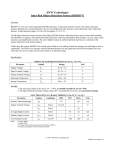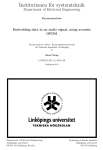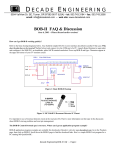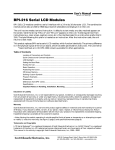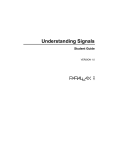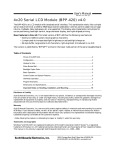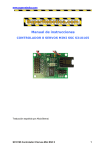Download Lab1: Basic Stamp II Digital I/O 305
Transcript
Abstract This report covers an introductory laboratory exercise done to interface Basic Stamp II digital I/O to various devices - an LED, a seven-segment display (TIL306), a 4x4 matrix keypad and a serial LCD display. The exercises involved include flashing an LED, displaying numeric inputs on the TIL306 and implementing a digital stopwatch on the LCD. Program codes used to implement the above are provided with comments so that readers can easily see how we did it. A components/price list is also provided for those who want to reproduce what we have done. Lab1: Basic Stamp II Digital I/O 305-554A: Microprocessors for Mechanical Systems 6th October 1999 1 Introduction One of the objectives of the laboratory exercise is for us to get acquainted with the PBASIC programming language. This is easily done because the PBASIC instruction set is relatively short and each command is well documented in the Basic Stamp II manual. Having previous programming experience helps but when we cannot get the program to work the way we want, the best place to go to is always the manual. Another objective is to interface the matrix keypad. This involves both hardware and software implementations. The hardware part is to connect the leads to the correct pins and setting up resistors to prevent the stamp from frying. The software part is to get the program to scan the pins for inputs (this will be elaborated later). After getting that right, we performed digital outputs to an LED and a TIL306 according to the inputs read from the matrix keypad. Finally, we interfaced a LCD display using a serial connection and the SEROUT command. 1.1 Tasks PBASIC programs have been written to perform the following tasks using abovementioned hardware: a. Turn a LED on and off in response to a keypad input The initial state of the LED is off, when Button 1 on the matrix keypad is pressed flash the LED once per second. When keypad Button 4 on the matrix keypad is pressed turn the flashing LED off. See figure 1 for hardware implementation. b. Interfacing a Seven Segment display Initialize the seven segment display (TIL 306) to show a blinking cursor. Then set it up to display the last key pressed on the matrix keypad. See figure 2 for hardware implementation. c. Implement a digital stopwatch on the LCD Group D: Yeow Wei Pang Anny Xie When keypad Button 2 is pressed, begin flashing the LED once per second and continuously display and update the time in seconds on the LCD. When keypad Button 5 is pressed, stop the clock and display the elapsed time. The next time Button 2 is pressed, the displayed elapsed time should be reset before beginning the count again. See figure 3 for hardware implementation. 2 Hardware Used 2.1 Basic Stamp II and Board of Education The "BASIC Stamp II" is a postage stamp sized product of Parallax Company. A BASIC Stamp is a PIC microcontroller that has been customized to understand the BASIC programming language. The use of the BASIC language makes it extremely easy to create software for the controller. The microcontroller chip can be purchased on a small carrier board that accepts a 9-volt battery, and can be programmed by plugging it into one of the ports on a desktop computer. See table 1 for Basic Stamp II features. RAM 26 bytes EEPROM 2K bytes Max program length about 600 instructions Execution speed 4000 lines/sec I/O pins 16 Table1: Basic Stamp II Features 2.2 LED This is a commonly used light emitting diode. 2.3 Seven Segment Display, TIL306 TIL306 seven-segment light-emitting-diode (LED) displays is produced by Texas Instrument company, it contain a BCD counter, a four-bit latch, and a decoder/LED driver in a single 16-pin package. The feature, mechanical data and terminal function can be found in http://www.cim.mcgill.ca/~venkat/554/NOTES/LAB1/til306.pdf 2.4 Matrix Orbital LCD, LCD1621 3 Laboratory Procedures In order to minimize the trouble during each lab exercise, before we start, we made sure that all the devices were in good condition and that they will perform as expected. Basically, this involves writing a test program to test the basic functions of the devices (LCD and TIL306). A multi-meter was also used to test the matrix keypad. While doing so, we found that one of the columns did not make a connection. The LCD used in this lab is the product of HVW Technologies company. The introduction, user manual, operating specifications and mechanical drawing and command set can be found in http://www.hvwtech.com/lcd.htm 2.5 4x4 Matrix Keypad 3.1 Lab Exercise 1: Turn a LED On and Off in Response To a Keypad Input 3.1.1 Keypad Test If one key is pressed, the corresponding row and column will be connected. So, simply by using a multi-meter (an ohmmeter in this case) we can know which lead corresponds to which row/column. Also we will be able to know if a connection is actually made. Note: When using the keypad, it should always lie flat on a surface. This is to prevent damaging the circuitry within the delicate membrane keypad. 3.1.2 LED test This test was to determine the polarity of the LED's leads. The diagram of this test is as follow. The keypad used in this lab is also the product of HVW Technologies company. It is a 4X4-membrane keypad. The configuration of the leads is as shown above. 2.6 Others Connect all the elements on the breadboard except the LED. Then plug LED in, if it lights up, the foot connected to the voltage is the positive polar, otherwise, it the negative one. Normally the longer foot is the positive polar, and this was proven in the test. 3.1.3 Procedures Resistors, breadboard, multi-meter, wires, wire-cutter, and a computer. 1. Complete the hardware connections according to figure 1. Make sure that the LED is connected in the right direction. 2. The other team member checks all the connections before powering up the system. 3. In the Basic Stamp programming window, edit and run the program. Make sure the PC is connected to the Board of Education via the serial cable. 4. Press button 1 on the keypad, check the LED. 5. If LED is not flashing correctly, plug out the power first. Repeat steps 2-5 until the LED does the right thing. Then press button 4. Check the result and edit the program if needed. 6. Measure and tune the accuracy of the system by comparing it with a watch/clock. 3.1.4 Documented Source Code 3.2 Lab Exercise 2: Interfacing a Seven Segment Display '''''''''''''''''''''''''''''''''''''''''''''''''''''''''' ' 305-554A Microprocessors for Mechanical Systems ' ' Group D: Pang, Yeow Wei ' ' Xie, Ling ' ' ' ' Lab 1 - Basic Stamp II Digital I/O ' ' a) Turn a LED on and off in response to a keypad input ' ' ' ' Description: Program is used to interface a matrix ' ' keypad to an LED. Flashing of the LED is ' ' controlled by 2 buttons. We could have ' ' used only 2 pins (1 input, 1 output) to ' ' implement this. However, 3 pins were used ' ' to experiment with a scanning technique. ' ' This proves to be useful for part b) of ' ' the lab. ' ' ' '''''''''''''''''''''''''''''''''''''''''''''''''''''''''' target flag var var byte bit ' target is byte ' flag is either 1/0 flag = 0 target = 0 DIRS = %1000000011110000 ' initialize flag ' initialize target ' initialize pin directions LOOP1: LOW 5 HIGH 4 BUTTON 0,1,255,0,target,1,LED_ON GOTO LOOP2 ' ' ' ' ' scanning R1 of keypad put pin 5 low put pin 4 high check if Button-1 is pressed continues to scan R2 LOOP2: LOW 4 HIGH 5 BUTTON 0,1,255,0,target,1,LED_OFF IF flag = 1 THEN LED_ON GOTO LOOP1 ' ' ' ' ' ' scanning R2 of keypad now put pin 4 low and pin 5 high check if Button-4 is pressed goto LED_ON only if flag is up continues to scan R1 LED_ON: flag = 1 HIGH 15 pause 50 LOW 15 pause 950 GOTO LOOP2 ' ' ' ' ' ' ' this section flashes LED set flag up put pin 15 high for 50 milliseconds put pin 15 low for 950 milliseconds continues to scan R2 LED_OFF: flag = 0 GOTO LOOP1 ' this section stops LED ' flag down ' continues to scan R1 3.2.1 TIL306 Tests Connect the GND and the Vcc leads of the TIL306. All the LED's on it should light up. If this is not the case, bring it to George Dedic or Georges Tewfik to report the problem. If all goes well, connect the remaining leads as shown on figure 2 and write a short program to pulse the CLK of the TIL306. 3.2.2 Procedures 1. Complete the hardware connections according to figure 2. Make sure that the TIL306 is connected to Vcc and GND correctly. 2. The other team member checks all the connections before powering up the system. 3. In the Basic Stamp programming window, edit and run the program. Make sure the PC is connected to the Board of Education via the serial cable. 4. Check the TIL 306 display. It should show “0” and a blinking decimal point. 5. If TIL306 display is not correct, plug out the voltage source. Repeat steps 2-5 until it has the right display. Then press any numerical button on the keypad. Check the result. It should display the last button pressed. Edit the program if needed. 3.2.3 Documented Source Code [Deleted ] 3.3 Lab Exercise 3: Implement a Digital Stopwatch On The LCD 3.3.1 LCD Preliminary Tests Check the DB9 pin I/O table of the LCD manual. Check the DB9 pin I/O table of the Basic Stamp II manual. Use a multi-meter (an ohmmeter in this case) to verify which side of the serial line should go to the LCD and which side goes to the Stamp. Next, check the jumper settings on the LCD and refer to its manual to see what it means and what it requires from the Stamp. Next go to the Basic Stamp II manual to check out the SEROUT command. Specifically, check how Tpin, Baudmode and OutputData should be configured. When all the above are done, write a short test program to test the LCD command set. 3.3.2 Procedures 1. Complete the hardware connections according to figure 3. Make sure that the LCD is connected to Vcc and GND correctly. 2. The other team member checks all the connections before powering up the system. 3. In the Basic Stamp programming window, edit and run the program. Make sure the PC is connected to the Board of Education via the serial cable. 4. Unplug the PC serial cable and plug the LCD serial cable to the Board of Education. 5. Press button 2 on the keypad, check the LED. It should flashing once per second. The LCD should also continuously display and update the time in second. 6. If LED and LCD display is not correct, unplug the power source. Repeat steps 26 until the LCD is displaying correctly. Then press button 5. Check the result. It should stop the clock and display the elapsed time. Edit the program if needed. 7. Pressing button 2 again should reset the LCD before beginning the count again. Edit the program if needed. 8. Measure and tune the accuracy of the stopwatch by comparing it with a watch/clock. 3.3.3 Documented Source Code [Source code deleted] 4 Component / Price List Components Basic Stamp II & Board of Education Matrix Orbital LCD Display TIL306, Numeric Display 4x4 Matrix Keypad LED Breadboard 1K Resistor 10k Resistor Basic Stamp II Manual v1.9 (pdf format) Wires Wire-cutter Multi-meter Computer Price USD $92.65 CDN $80 CDN $9.90 CDN $15 USD $0.25 CDN $18.60 Free Free Free Free Free Free Free Qty. 1 1 1 1 1 1 3 3 1 lots 1 1 1 Source Parallaxinc HVW tech. Meas. Lab. HVW tech. Jameco Digikey Meas. Lab. Meas. Lab. Parallaxinc Meas. Lab. Meas. Lab. Meas. Lab. Meas. Lab. 5 Discussion The laboratory exercises had been useful in helping us learn the PBASIC language and getting us used to the Basic Stamp II working environment. Through the exercises, we also got to see its programming limitations. For example, multitasking is not possible and to implement an alternative would make the programming slightly more tedious. For this reason, the matrix keypad is not responsive when we tried to stop the stopwatch or stop the LED from flashing since the program pauses and does nothing during that 1-second duration. Instead, it could have gone off to continue scanning for other keypad inputs. Due to time constraints, that was not implemented in our program. We also got the stopwatch to be reasonably accurate. In our trials, no time was lost or gained in a 10-minute period. This could be improved of course if we had let the stopwatch run for 18-hrs (64800-seconds) and factored in the time lost/gained in the pause command. According to our program, approximately 33-milliseconds (1000 - 957 - 10) were used to scan the matrix keypad. The other objectives were accomplished with the successful completion of all 3laboratory exercises. A program that combines all 3 previous programs is attached in the Appendix (section 8.2). 6 Conclusion We have interfaced the Basic Stamp II I/O with a matrix keypad, an LED and a serial LCD display. We have gained some insights into the programming of a microcontroller. The next step to all these is of course to use the knowledge learnt here and implement other cool projects. For example, a bunch of flickering Christmas tree lights, a calculator, a Y2K countdown clock, a fake time bomb, etc. The list is endless of course. 7 Contributions of Each Member Anny Xie Wrote test program for LED Software Hardware Documentation Wrote code for LCD using the SEROUT command Connected circuits according to circuit diagrams Implemented LED and keypad tests Laboratory procedures Tasks, hardware used sections Title page, component/price list, appendix Yeow Wei Pang Wrote test programs for LCD display and TIL306 Wrote code for scanning matrix keypad Checked connections of circuit before powering up system Labeled wires and tidied up circuit Drew circuit diagrams Included relevant pictures Abstract, introduction, discussion and conclusion Documented source codes 8 Appendix 8.1 Referenced Websites • • • • • • • http://www.parallaxinc.com http://www.cim.mcgill.ca/~venkat/554/NOTES/LAB1/til306.html http://www.cim.mcgill.ca/~venkat/554/NOTES/LAB1/til306.pdf http://www.hvwtech.com/lcd.htm http://www.howstuffworks.com/microcontroller.htm http://www.jameco.com/Catalog/default.html http://canada.digikey.com 8.2 Documented Source Code of Combined Program [Deleted] THE END






